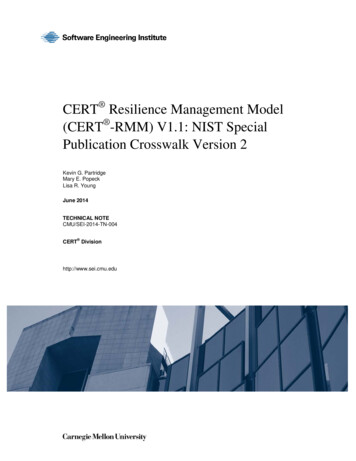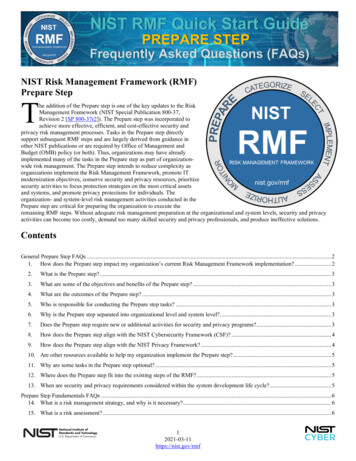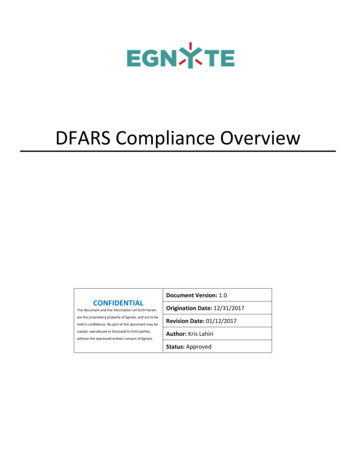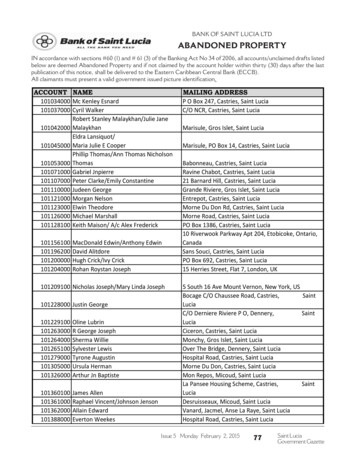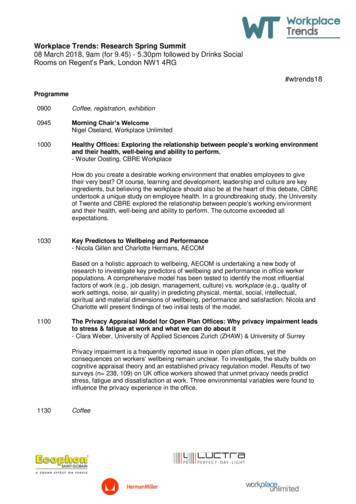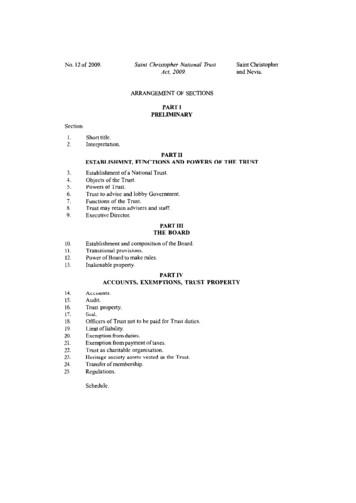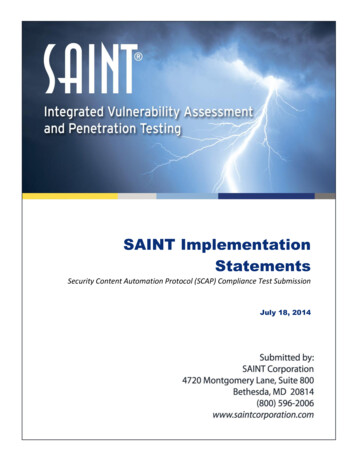
Transcription
SAINT ImplementationStatementsSecurity Content Automation Protocol (SCAP) Compliance Test SubmissionJuly 18, 2014
SAINT SCAP Implementation Statements July 18, 2014Table of ContentsPurpose.3SAINT Implementation Statements .4SAINT Corporation 2
SAINT SCAP Implementation Statements July 18, 2014PurposeThe purpose of this document is to submit SAINT Corporation’s Implementation Statements applicable to the followingSecurity Content Automation Protocol (SCAP) capabilities specified under SCAP v.1.2 standards: Authenticated Configuration Scanner (ACS) andCommon Vulnerabilities and Exposures (CVE)SAINT Corporation submits its flagship product, SAINT 8 Security Suite, for validation and acknowledges that this productwill support all Windows and Linux platforms that are included as part of the SCAP Validation Program, specifically: Microsoft Windows XP Professional with Service Pack 3Microsoft Windows Vista with Service Pack 2Microsoft Windows 7, 32- and 64-bitRed Hat Enterprise Linux 5 Desktop, 32- and 64-bitThese capabilities include the following SCAP components: eXtensible Configuration Checklist Description Format (XCCDF)Open Vulnerability and Assessment Language (OVAL )Common Configuration Enumeration (CCE )Common Platform Enumeration (CPE )Common Vulnerabilities and Exposures (CVE )Common Vulnerability Scoring System (CVSS)Asset Identification (AI)Asset Reporting Format (ARF)Trust Model for Security Automation Data (TMSAD)This document is one of two deliverables required for this process. Also reference SAINT Corporation’s deliverabledocument “Required Vendor Information”, dated July 18, 2014 for details related to this submission.SAINT Corporation 3
SAINT SCAP Implementation Statements July 18, 2014SAINT Implementation StatementsSCAPSAINT 8 Security Suite provides support to the Security Content Automation Protocol (SCAP) specification as anAuthenticated Configuration Scanner (ACS), including the Common Vulnerabilities and Exposures (CVE) option. SAINT 8provides support to SCAP requirements defined for each of these components, as defined in SP 800-126, Revision 2, theSCAP specification, and verified by compliance testing against the Security Content Automation Protocol (SCAP) Version1.2 Validation Program Test Requirements (NISTIR 7511, Revision 3), dated January 2013 – including updates as of July2013.SAINT 8 Security Suite is the major release from SAINT Corporation submitted to a NIST-approved test lab for validationwith the SCAP Version 1.2 standards. SAINT 8’s release strategy includes a numbering convention that delivers periodicfeature releases (8.x) and security content (8.x.x) that offer added capabilities and functionality since the 8.0 launch in2013. SAINT 8’s version 8.4 was the tested version in 2014 and validates SAINT 8 compliance with the SCAP v.1.2standard as of SAINT 8.4 and above.SAINT 8 provides support for open standards languages, enumerations and metrics that currently include XCCDF, OVAL,CCE, CPE, CVE and CVSS, AI, ARF and TMSAD of the specification. SAINT 8 also provides support for the U.S. GovernmentConfiguration Baseline (USGCB) by ingesting valid SCAP-expressed data streams and assessing target configurationsagainst these baselines. This capability also includes support for evaluating SCAP content to scan for compliance,vulnerabilities, and patches using both standalone OVAL definition files and OVAL definitions contained in SCAPexpressed data streams.SAINT 8 completes this capability by providing data analysis, links to external authoritative sources of information, policyediting and reporting interfaces, to facilitate local policy investigation and analysis. Compliance reporting is provided viapre-defined report templates and custom presentation of output in machine-readable and many human-readableformats, such as HTML, PDF, XML and CSV.USGCBSAINT Corporation asserts that the SAINT 8 Security Suite is fully functional and operates correctly as intended onsystems using the U.S. Government Configuration Benchmark (USGCB). Target settings applicable to performing USGCBassessments are defined in the SCAP section the SAINT 8 User Guide. To run a scan, the targets must meet only therequirements for running a normal SAINT 8 authenticated scan. Targets can be scanned for USGCB compliance byimporting the desired USGCB SCAP Data Stream containing XCCDF and OVAL document formats, and selecting it whenchoosing a scan policy to run. USGCB scans make use of CCE to simply tracking of configuration issues found during ascan. SAINT 8 produces multiple reports in both the required formats for SCAP and some non-required formats for dataanalysis. The reports are viewable in the SCAP Data section of the GUI and can also be bundled and downloaded tosupport external requirements such as content backups, compliance reporting or importing into other applications.XCCDFXCCDF (eXtensible Common Configuration Data Format) is a specification language for writing security checklists,benchmarks and related types of documents, as defined by NIST. SAINT 8 provides the capability to import, validate,view, execute policy scans, and report on benchmarks in XCCDF format, Version 1.2. SAINT 8 provides two methods ofcollection: 1) Select a supported policy to validate and Import or Update content; and 2) Use the Upload Benchmarkoption in the SCAP data grid to manually import definitions for validation and execution by SAINT’s scanning engine. Thiscapability includes support for importing SCAP expressed data-streams in ZIP and XML formats.SAINT Corporation 4
SAINT SCAP Implementation Statements July 18, 2014SAINT 8 also provides a Policy Editor for those users that wish to use an existing XCCDF-based policy as a template toedit and save a custom policy to support local requirements. This editor allows users to view such information as thedetailed descriptions of each group and rule contained in a policy; and to enable checks, disable checks (rules) andmodify values associated with certain rules.XCCDF-based scan results can be viewed or downloaded in a number of compliance formats: XCCDF Results document;XCCDF Human readable results document; OVAL system characteristics for each target; and OVAL Results documentsthat resulted from the XCCDF scan.OVALOpen Vulnerability and Assessment Language (OVAL) is an international information security standard to promote openand publicly available security content, and to standardize the transfer of this information across the entire spectrum ofsecurity tools and services. SAINT 8 supports OVAL definitions of the patch, vulnerability, compliance and inventory classfor most platforms and adheres to the latest OVAL schema (e.g. v.5.10.1 as of the date of SCAP v.1.2 validation). TheSAINT 8 scanning engine then consumes and executes selected definitions and assesses hosts, without the need for alocal agent or plug-in, to determine and report issues found on the hosts.SAINT 8 supports OVAL compliance checking by allowing users to import OVAL checks (standalone and/or SCAPexpressed data streams) from the OVAL repository, as well as importing user-developed XML files containing OVALchecks. An SCAP-expressed data stream is defined as “a collection of four or more related XML files containing SCAPdata using the SCAP components that provide the data necessary to evaluate systems for compliance with aconfiguration-based security policy”. SAINT 8 also provides viewing and downloading OVAL result files via the GUI, aswell as viewing human readable (non XML) results.CCECommon Configuration Enumeration (CCE) is a dictionary of names for software security configuration issues (e.g.,access control settings, password policy settings). As such, CCEs describe system configuration issues to facilitatecorrelation of configuration data across multiple information sources and tools. SAINT 8 provides support for CCE’s bydisplaying CCE IDs, in accordance with the specifications and CCE 5.0 schema located on the Mitre.org CCE website foreach configuration item in scanning results produced for XCCDF scanning policies and profiles. SAINT 8 also providesdata drill-down and report configuration options that include displaying CCE ID and Descriptions. CCE IDs are displayedin several of the different reports offered via the Data Analysis - SCAP Results page. These include the required outputformat defined as “CCE ID, pass/fail” and a detail format which organizes results by XCCDF Rules, and displays results foreach XCCDF Rule, to include: the CCE IDs; CCE descriptions; whether or not the CCE passed/failed against the targetsystem; and why the CCE passed/failed against the target system. SAINT 8 provides a policy editor to allow users todisable and enable configuration checks by CCE to meet specific network requirements.CPECPE (Common Platform Enumeration) is a structured naming scheme for information technology systems, software andpackages. SAINT 8 provides support for CPE, version 2.3, by using the CPE names which are defined in the official CPEdictionary then mapping all known CVE(s) to the corresponding CPE(s) for a given year. SAINT 8 also facilitates CPEcontent updates directly from the authoritative source, as a product feature, to remove the burden of data maintenancefrom the user and to ensure accurate and complete source data when CPE data is used. This CVE-CPE mapping is usedwithin the reporting component as an available option in custom reports.Custom reporting features enable users to select all vulnerabilities in a given severity level, as well as define reportparameters and options related to specific vulnerability categories and services, such as CPE, to display the CPE entriesSAINT Corporation 5
SAINT SCAP Implementation Statements July 18, 2014corresponding to the displayed vulnerability, if any. SAINT’s reporting options also enable users to select the outputformat from a number of available formats, such as HTML, XML and CSV.CVECVE (Common Vulnerabilities and Exposures) is a dictionary of publicly known information security vulnerabilities andother information security exposures. The CVE repository is maintained by MITRE and is a free-use site. SAINT 8 providessupport for CVE with the capability to execute vulnerability scans for vulnerabilities by CVE ID. SAINT 8 internallyidentifies vulnerabilities by its proprietary vulnerability check IDs and then cross-references with CVE names. SAINT 8returns all vulnerability checks that detect the CVE and includes CVE numbers in its vulnerability data analysis, reportsand tutorials for ease of reference to related tools and resources. At the conclusion of vulnerability scan execution,SAINT 8 provides users with the capability to view the list of vulnerabilities and continue the analysis by supportingcustomized scanning by selected CVE for a given vulnerability or by selecting other categories or values relevant to theanalysis.SAINT 8’s analytical and report writing features then provide the capability to produce report output containing CVE IDs,in a number of formats, such as HTML, XML and CSV. SAINT 8 also provides hyperlinks to related resources, such as theSAINT on-line CVE Index, which includes the CVE ID, Description and custom SAINT tutorials; as well as linking directly tothe official CVEs descriptions from the Mitre.org CVE website to facilitate further analysis, assessment and remediation.CVE data is updated dynamically by SAINT as part of each release/update cycle – routinely twice each week. The“Generated Date” (by MITRE) and “Updated Date” (by SAINT) are part of this content. Note that there is a subclass ofCVEs, called "candidates" that are potential CVEs but have not yet been approved. The candidate CVEs are prefixed by"CAN" in the SAINT/CVE cross-reference list. When candidates become approved in a new CVE version, they are movedfrom the "CAN" section of the cross-reference list to the "CVE" section, and then made available for report output andvulnerability tutorials. The SAINT/CVE cross-reference list includes CAN and CVE entries on the same page, so thebrowser's search function can search for both CVE and CAN entries when the YYYY-NNNN portion of the identifiers arespecified in the search. The complete list of CVEs supported by SAINT can be found on our customer portal site(mySAINT).CVSSCVSS (Common Vulnerability Scoring System) is “a vulnerability scoring system designed to provide an open andstandardized method for rating Information Technology vulnerabilities framework for communicating the characteristicsand impacts of IT vulnerabilities”. CVSS helps organizations prioritize and coordinate a joint response to securityvulnerabilities by communicating the base, temporal, and environmental properties of a vulnerability. For moreinformation see the CVSS web site.SAINT 8 provides support for CVSS through scanning, analysis and reporting capabilities. SAINT 8 provides users with thecapability to create custom scanning policies that include specified CVSS ranges when defining scan levels and setting upcustom scans. SAINT 8’s reporting options also enable the user to show the CVSS base score and CVSS base vector foreach vulnerability detected, as an optional column, when creating custom reports. Custom reporting features within theReport tab enable users to select all vulnerabilities in a given severity level, as well as define report parameters andoptions related to specific vulnerability categories and services, such as CVSS base scores and CVSS base vectors, todisplay the CPE entries corresponding to displayed vulnerability, if any. SAINT 8 then enables users to select their outputformat from a number of available formats, such as HTML, XML and CSV. Additionally, SAINT 8 provides support for CVSSas part of Payment Card Industry (PCI) Compliance. CVSS base scores are shown in SAINT 8 as part of PCI complianceSAINT Corporation 6
SAINT SCAP Implementation Statements July 18, 2014reports. CVSS base scores are used as the primary factor in determining whether a given device is compliant during aPCI compliance assessment.SAINT imports CVSS base scores, CVSS vectors and “date generated” from the National Vulnerability Database (NVD)and delivers that information, as well as the date updated by SAINT, to our customers through our SAINTexpressmaintenance release process. The raw CVSS content is stored in the product database and is also available in theconfiguration sub-directory of the SAINT installation directory (e.g., config/cve-cvss). Each line in the cve-cvss filecontains the name of the source file the data following that line was extracted from, along with both the “generated”and “updated” dates for the source file - prefixed with the "#" character.Asset Identification (AI)Asset Identification (AI), under SCAP, is a format for uniquely identifying assets based on known identifiers and/orknown information about the assets. The SCAP specification describes the purpose of asset identification, a data modelfor identifying assets, methods for identifying assets, and guidance on how to use asset identification. It also identifies anumber of known use cases for asset identification.SAINT 8 supports the AI specification, version 1.1, by generating Asset Identifiers as part of the Asset Report Format(ARF) output. Output generated for scans are executed for any SCAP scan profile or benchmark, for both OVAL andXCCDF content. Asset identifiers are made available as content in the pre-configured ARF output in the SCAP module, byselecting a completed OVAL or XCCDF scan and viewing the ARF Report from the Manage Results Data page. AssetIdentifiers are then available to users by selecting individual output files for any target assessed during the scan. The AIand ARF report can then be viewed within the SCAP user interface or exported in XML format to support localrequirements and/or compliance reporting.Asset Reporting Format (ARF)The Asset Reporting Format (ARF), under SCAP, expresses the transport format of information about assets and therelationships between assets and reports. The SCAP specification prescribes the standardized data model to facilitatethe reporting, correlating and fusing of asset information throughout and between organizations.SAINT 8 supports the ARF specification, version 1.1, by generating ARF-formatted output. Output generated for scansare executed for any SCAP scan profile or benchmark, for both OVAL and XCCDF content. ARF formatted output is madeavailable as pre-configured output in the SCAP module, by selecting a complete scan and viewing the SCAP-compatibleresults from the Manage Results Data page. The final ARF output is then made available as one of selectable outputformats for individual targets assessed during the scan. The ARF report can then be viewed within the SCAP userinterface or exported in XML format to support local requirements and/or compliance reporting.Trust Model for Security Automation Data (TMSAD)The SCAP Trust Model for Security Automation Data (TMSAD) is a specification for using digital signatures in a commontrust model applied to other security automation specifications. The SCAP specification prescribes the standardized datamodel for establishing trust for security automation data.SAINT 8 supports the TMSAD specification, version 1.0, by verifying the XML signature to ensure content has not beenmodified. If a signature is not valid, SAINT 8 aborts the scan and generates an error to notify the user of the failed scan.SAINT Corporation 7
The purpose of this document is to submit SAINT Corporation's Implementation Statements applicable to the following Security Content Automation Protocol (SCAP) capabilities specified under SCAP v.1.2 standards: Authenticated Configuration Scanner (ACS) and Common Vulnerabilities and Exposures (CVE)
